Crowd-Sourced Funding: An Analysis of the New Regimes in Australia
VerifiedAdded on 2022/10/15
|11
|2318
|360
AI Summary
This essay analyzes the effectiveness of the new regimes for crowd-sourced funding and their applicability towards companies, intermediaries, and investors in Australia. It discusses the risks and liabilities of crowd-sourced funding and the current regimes in place. The essay also covers the exemptions of the rules of takeover, cooling off period, corporate governance, and ASIC levy. The subject is Business and Corporate Law, and the course code is 8. The document type is an essay, and the assignment type is not mentioned. The college or university is not mentioned.
Contribute Materials
Your contribution can guide someone’s learning journey. Share your
documents today.
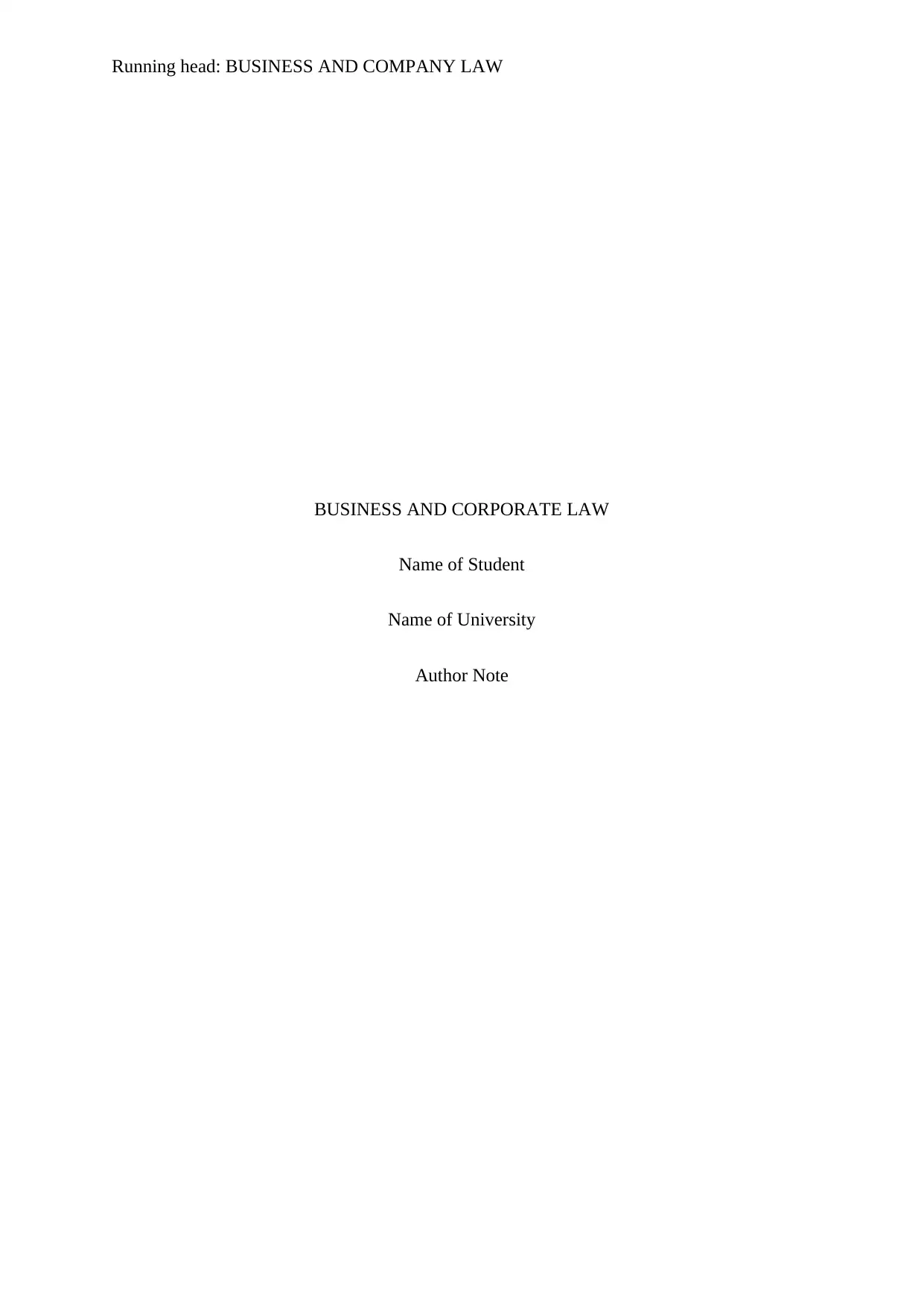
Running head: BUSINESS AND COMPANY LAW
BUSINESS AND CORPORATE LAW
Name of Student
Name of University
Author Note
BUSINESS AND CORPORATE LAW
Name of Student
Name of University
Author Note
Secure Best Marks with AI Grader
Need help grading? Try our AI Grader for instant feedback on your assignments.
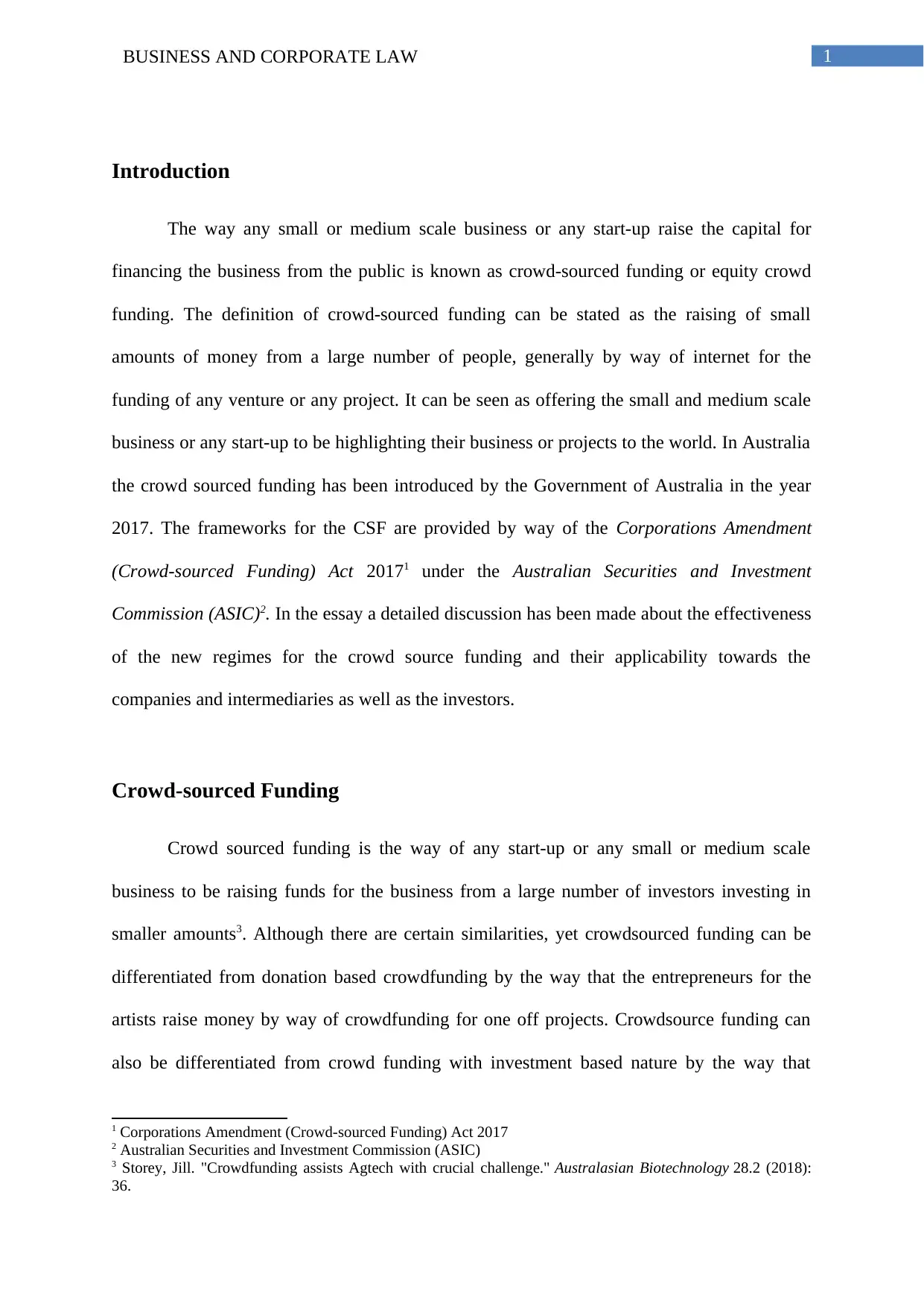
1BUSINESS AND CORPORATE LAW
Introduction
The way any small or medium scale business or any start-up raise the capital for
financing the business from the public is known as crowd-sourced funding or equity crowd
funding. The definition of crowd-sourced funding can be stated as the raising of small
amounts of money from a large number of people, generally by way of internet for the
funding of any venture or any project. It can be seen as offering the small and medium scale
business or any start-up to be highlighting their business or projects to the world. In Australia
the crowd sourced funding has been introduced by the Government of Australia in the year
2017. The frameworks for the CSF are provided by way of the Corporations Amendment
(Crowd-sourced Funding) Act 20171 under the Australian Securities and Investment
Commission (ASIC)2. In the essay a detailed discussion has been made about the effectiveness
of the new regimes for the crowd source funding and their applicability towards the
companies and intermediaries as well as the investors.
Crowd-sourced Funding
Crowd sourced funding is the way of any start-up or any small or medium scale
business to be raising funds for the business from a large number of investors investing in
smaller amounts3. Although there are certain similarities, yet crowdsourced funding can be
differentiated from donation based crowdfunding by the way that the entrepreneurs for the
artists raise money by way of crowdfunding for one off projects. Crowdsource funding can
also be differentiated from crowd funding with investment based nature by the way that
1 Corporations Amendment (Crowd-sourced Funding) Act 2017
2 Australian Securities and Investment Commission (ASIC)
3 Storey, Jill. "Crowdfunding assists Agtech with crucial challenge." Australasian Biotechnology 28.2 (2018):
36.
Introduction
The way any small or medium scale business or any start-up raise the capital for
financing the business from the public is known as crowd-sourced funding or equity crowd
funding. The definition of crowd-sourced funding can be stated as the raising of small
amounts of money from a large number of people, generally by way of internet for the
funding of any venture or any project. It can be seen as offering the small and medium scale
business or any start-up to be highlighting their business or projects to the world. In Australia
the crowd sourced funding has been introduced by the Government of Australia in the year
2017. The frameworks for the CSF are provided by way of the Corporations Amendment
(Crowd-sourced Funding) Act 20171 under the Australian Securities and Investment
Commission (ASIC)2. In the essay a detailed discussion has been made about the effectiveness
of the new regimes for the crowd source funding and their applicability towards the
companies and intermediaries as well as the investors.
Crowd-sourced Funding
Crowd sourced funding is the way of any start-up or any small or medium scale
business to be raising funds for the business from a large number of investors investing in
smaller amounts3. Although there are certain similarities, yet crowdsourced funding can be
differentiated from donation based crowdfunding by the way that the entrepreneurs for the
artists raise money by way of crowdfunding for one off projects. Crowdsource funding can
also be differentiated from crowd funding with investment based nature by the way that
1 Corporations Amendment (Crowd-sourced Funding) Act 2017
2 Australian Securities and Investment Commission (ASIC)
3 Storey, Jill. "Crowdfunding assists Agtech with crucial challenge." Australasian Biotechnology 28.2 (2018):
36.
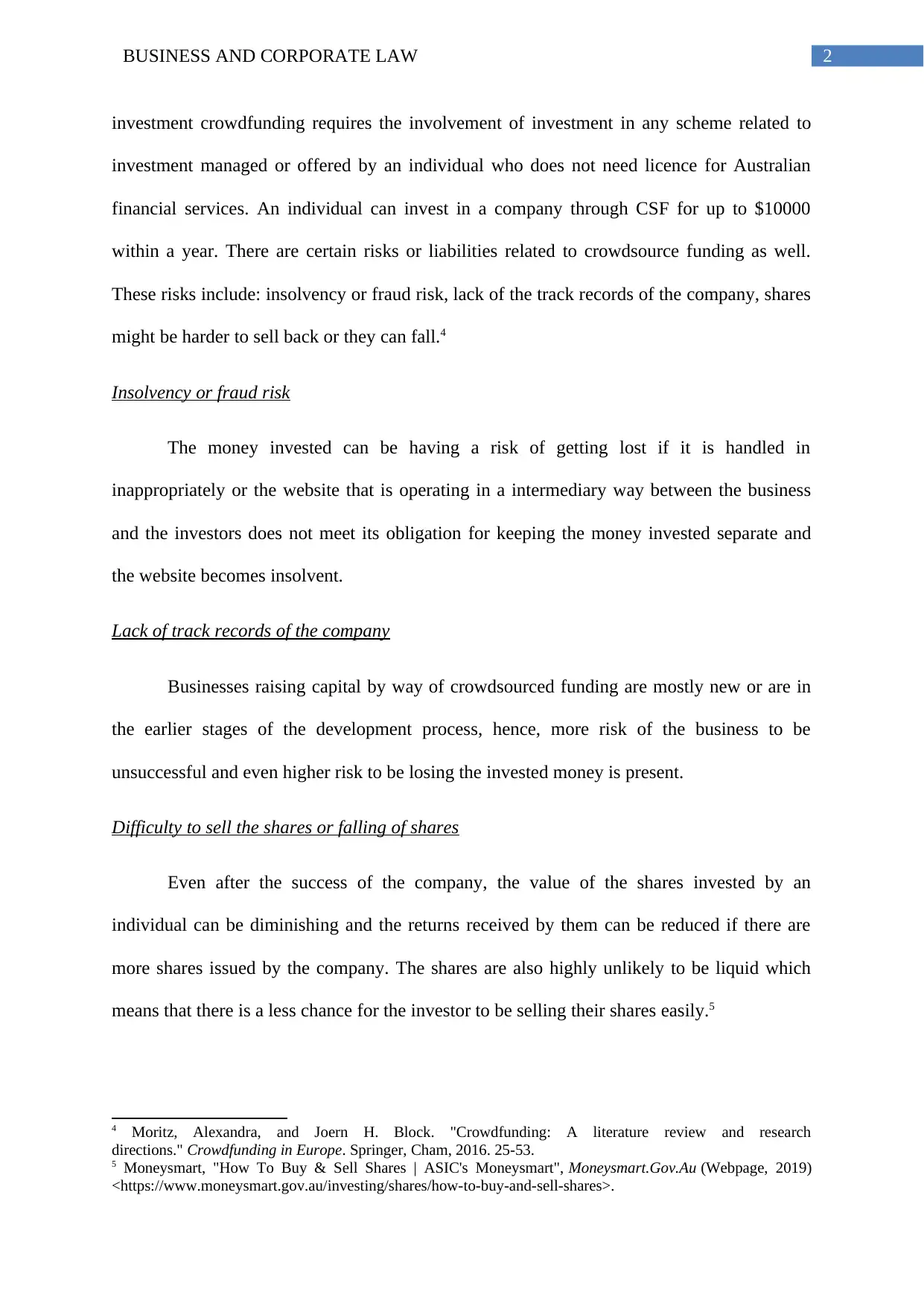
2BUSINESS AND CORPORATE LAW
investment crowdfunding requires the involvement of investment in any scheme related to
investment managed or offered by an individual who does not need licence for Australian
financial services. An individual can invest in a company through CSF for up to $10000
within a year. There are certain risks or liabilities related to crowdsource funding as well.
These risks include: insolvency or fraud risk, lack of the track records of the company, shares
might be harder to sell back or they can fall.4
Insolvency or fraud risk
The money invested can be having a risk of getting lost if it is handled in
inappropriately or the website that is operating in a intermediary way between the business
and the investors does not meet its obligation for keeping the money invested separate and
the website becomes insolvent.
Lack of track records of the company
Businesses raising capital by way of crowdsourced funding are mostly new or are in
the earlier stages of the development process, hence, more risk of the business to be
unsuccessful and even higher risk to be losing the invested money is present.
Difficulty to sell the shares or falling of shares
Even after the success of the company, the value of the shares invested by an
individual can be diminishing and the returns received by them can be reduced if there are
more shares issued by the company. The shares are also highly unlikely to be liquid which
means that there is a less chance for the investor to be selling their shares easily.5
4 Moritz, Alexandra, and Joern H. Block. "Crowdfunding: A literature review and research
directions." Crowdfunding in Europe. Springer, Cham, 2016. 25-53.
5 Moneysmart, "How To Buy & Sell Shares | ASIC's Moneysmart", Moneysmart.Gov.Au (Webpage, 2019)
<https://www.moneysmart.gov.au/investing/shares/how-to-buy-and-sell-shares>.
investment crowdfunding requires the involvement of investment in any scheme related to
investment managed or offered by an individual who does not need licence for Australian
financial services. An individual can invest in a company through CSF for up to $10000
within a year. There are certain risks or liabilities related to crowdsource funding as well.
These risks include: insolvency or fraud risk, lack of the track records of the company, shares
might be harder to sell back or they can fall.4
Insolvency or fraud risk
The money invested can be having a risk of getting lost if it is handled in
inappropriately or the website that is operating in a intermediary way between the business
and the investors does not meet its obligation for keeping the money invested separate and
the website becomes insolvent.
Lack of track records of the company
Businesses raising capital by way of crowdsourced funding are mostly new or are in
the earlier stages of the development process, hence, more risk of the business to be
unsuccessful and even higher risk to be losing the invested money is present.
Difficulty to sell the shares or falling of shares
Even after the success of the company, the value of the shares invested by an
individual can be diminishing and the returns received by them can be reduced if there are
more shares issued by the company. The shares are also highly unlikely to be liquid which
means that there is a less chance for the investor to be selling their shares easily.5
4 Moritz, Alexandra, and Joern H. Block. "Crowdfunding: A literature review and research
directions." Crowdfunding in Europe. Springer, Cham, 2016. 25-53.
5 Moneysmart, "How To Buy & Sell Shares | ASIC's Moneysmart", Moneysmart.Gov.Au (Webpage, 2019)
<https://www.moneysmart.gov.au/investing/shares/how-to-buy-and-sell-shares>.
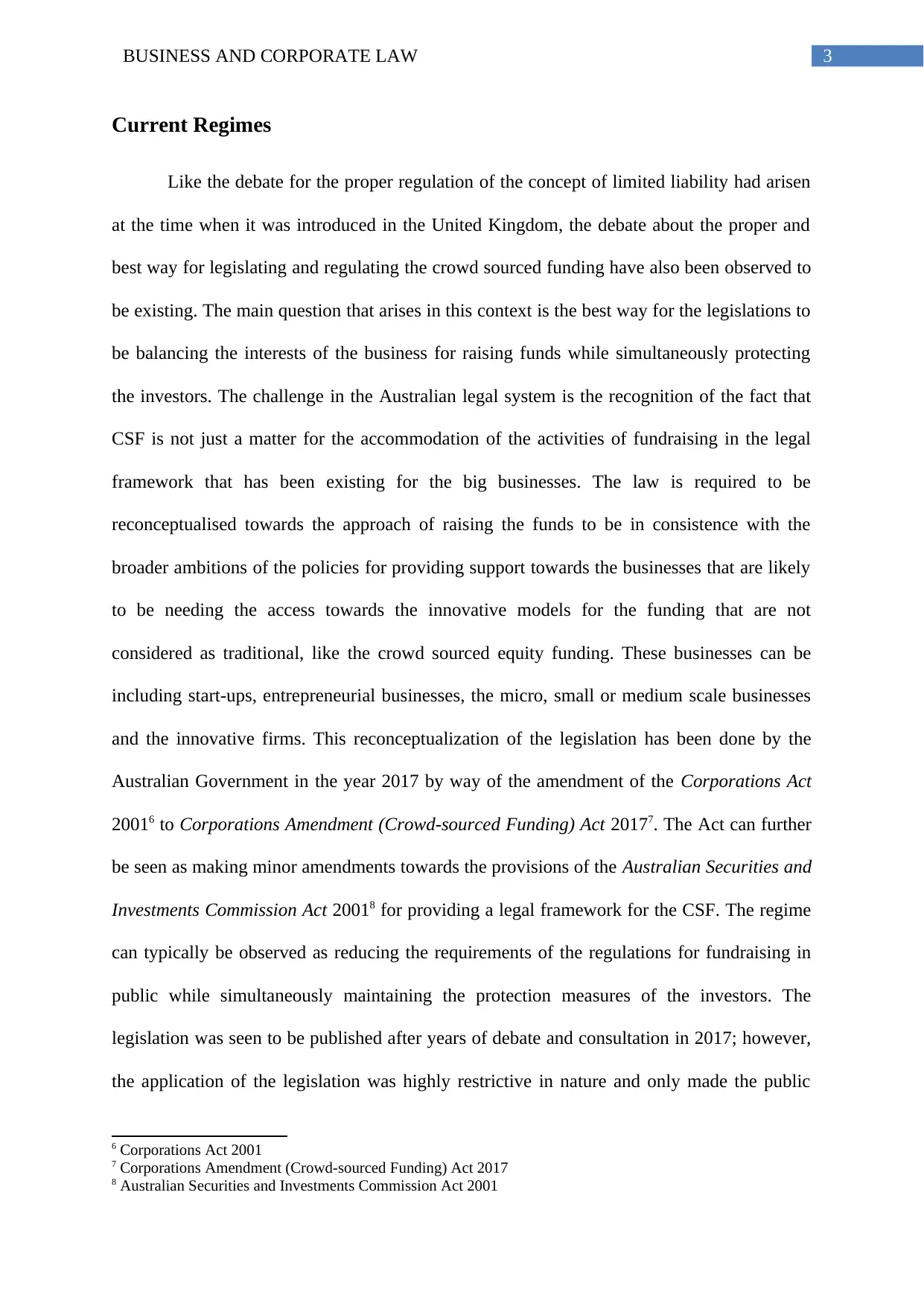
3BUSINESS AND CORPORATE LAW
Current Regimes
Like the debate for the proper regulation of the concept of limited liability had arisen
at the time when it was introduced in the United Kingdom, the debate about the proper and
best way for legislating and regulating the crowd sourced funding have also been observed to
be existing. The main question that arises in this context is the best way for the legislations to
be balancing the interests of the business for raising funds while simultaneously protecting
the investors. The challenge in the Australian legal system is the recognition of the fact that
CSF is not just a matter for the accommodation of the activities of fundraising in the legal
framework that has been existing for the big businesses. The law is required to be
reconceptualised towards the approach of raising the funds to be in consistence with the
broader ambitions of the policies for providing support towards the businesses that are likely
to be needing the access towards the innovative models for the funding that are not
considered as traditional, like the crowd sourced equity funding. These businesses can be
including start-ups, entrepreneurial businesses, the micro, small or medium scale businesses
and the innovative firms. This reconceptualization of the legislation has been done by the
Australian Government in the year 2017 by way of the amendment of the Corporations Act
20016 to Corporations Amendment (Crowd-sourced Funding) Act 20177. The Act can further
be seen as making minor amendments towards the provisions of the Australian Securities and
Investments Commission Act 20018 for providing a legal framework for the CSF. The regime
can typically be observed as reducing the requirements of the regulations for fundraising in
public while simultaneously maintaining the protection measures of the investors. The
legislation was seen to be published after years of debate and consultation in 2017; however,
the application of the legislation was highly restrictive in nature and only made the public
6 Corporations Act 2001
7 Corporations Amendment (Crowd-sourced Funding) Act 2017
8 Australian Securities and Investments Commission Act 2001
Current Regimes
Like the debate for the proper regulation of the concept of limited liability had arisen
at the time when it was introduced in the United Kingdom, the debate about the proper and
best way for legislating and regulating the crowd sourced funding have also been observed to
be existing. The main question that arises in this context is the best way for the legislations to
be balancing the interests of the business for raising funds while simultaneously protecting
the investors. The challenge in the Australian legal system is the recognition of the fact that
CSF is not just a matter for the accommodation of the activities of fundraising in the legal
framework that has been existing for the big businesses. The law is required to be
reconceptualised towards the approach of raising the funds to be in consistence with the
broader ambitions of the policies for providing support towards the businesses that are likely
to be needing the access towards the innovative models for the funding that are not
considered as traditional, like the crowd sourced equity funding. These businesses can be
including start-ups, entrepreneurial businesses, the micro, small or medium scale businesses
and the innovative firms. This reconceptualization of the legislation has been done by the
Australian Government in the year 2017 by way of the amendment of the Corporations Act
20016 to Corporations Amendment (Crowd-sourced Funding) Act 20177. The Act can further
be seen as making minor amendments towards the provisions of the Australian Securities and
Investments Commission Act 20018 for providing a legal framework for the CSF. The regime
can typically be observed as reducing the requirements of the regulations for fundraising in
public while simultaneously maintaining the protection measures of the investors. The
legislation was seen to be published after years of debate and consultation in 2017; however,
the application of the legislation was highly restrictive in nature and only made the public
6 Corporations Act 2001
7 Corporations Amendment (Crowd-sourced Funding) Act 2017
8 Australian Securities and Investments Commission Act 2001
Secure Best Marks with AI Grader
Need help grading? Try our AI Grader for instant feedback on your assignments.
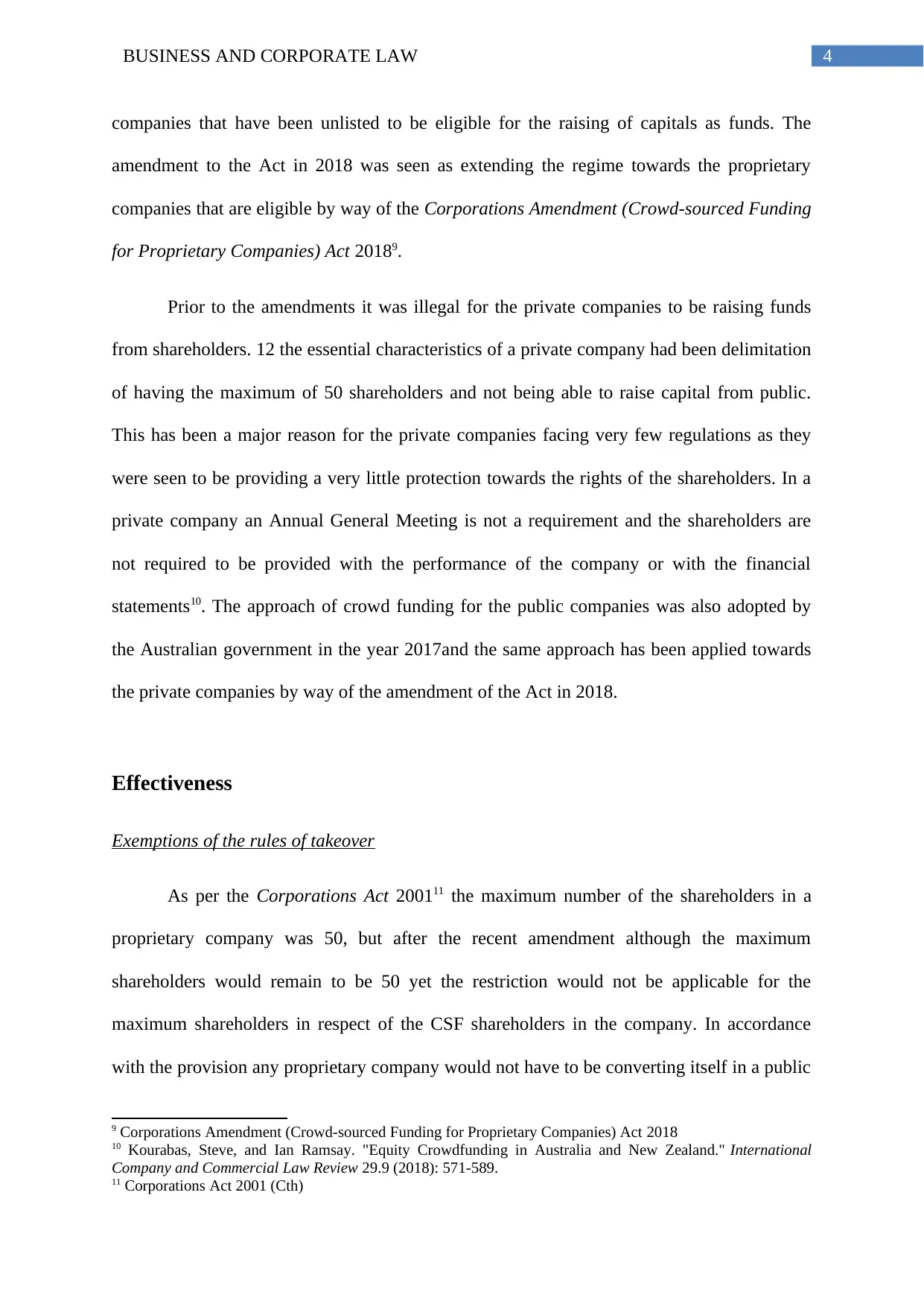
4BUSINESS AND CORPORATE LAW
companies that have been unlisted to be eligible for the raising of capitals as funds. The
amendment to the Act in 2018 was seen as extending the regime towards the proprietary
companies that are eligible by way of the Corporations Amendment (Crowd-sourced Funding
for Proprietary Companies) Act 20189.
Prior to the amendments it was illegal for the private companies to be raising funds
from shareholders. 12 the essential characteristics of a private company had been delimitation
of having the maximum of 50 shareholders and not being able to raise capital from public.
This has been a major reason for the private companies facing very few regulations as they
were seen to be providing a very little protection towards the rights of the shareholders. In a
private company an Annual General Meeting is not a requirement and the shareholders are
not required to be provided with the performance of the company or with the financial
statements10. The approach of crowd funding for the public companies was also adopted by
the Australian government in the year 2017and the same approach has been applied towards
the private companies by way of the amendment of the Act in 2018.
Effectiveness
Exemptions of the rules of takeover
As per the Corporations Act 200111 the maximum number of the shareholders in a
proprietary company was 50, but after the recent amendment although the maximum
shareholders would remain to be 50 yet the restriction would not be applicable for the
maximum shareholders in respect of the CSF shareholders in the company. In accordance
with the provision any proprietary company would not have to be converting itself in a public
9 Corporations Amendment (Crowd-sourced Funding for Proprietary Companies) Act 2018
10 Kourabas, Steve, and Ian Ramsay. "Equity Crowdfunding in Australia and New Zealand." International
Company and Commercial Law Review 29.9 (2018): 571-589.
11 Corporations Act 2001 (Cth)
companies that have been unlisted to be eligible for the raising of capitals as funds. The
amendment to the Act in 2018 was seen as extending the regime towards the proprietary
companies that are eligible by way of the Corporations Amendment (Crowd-sourced Funding
for Proprietary Companies) Act 20189.
Prior to the amendments it was illegal for the private companies to be raising funds
from shareholders. 12 the essential characteristics of a private company had been delimitation
of having the maximum of 50 shareholders and not being able to raise capital from public.
This has been a major reason for the private companies facing very few regulations as they
were seen to be providing a very little protection towards the rights of the shareholders. In a
private company an Annual General Meeting is not a requirement and the shareholders are
not required to be provided with the performance of the company or with the financial
statements10. The approach of crowd funding for the public companies was also adopted by
the Australian government in the year 2017and the same approach has been applied towards
the private companies by way of the amendment of the Act in 2018.
Effectiveness
Exemptions of the rules of takeover
As per the Corporations Act 200111 the maximum number of the shareholders in a
proprietary company was 50, but after the recent amendment although the maximum
shareholders would remain to be 50 yet the restriction would not be applicable for the
maximum shareholders in respect of the CSF shareholders in the company. In accordance
with the provision any proprietary company would not have to be converting itself in a public
9 Corporations Amendment (Crowd-sourced Funding for Proprietary Companies) Act 2018
10 Kourabas, Steve, and Ian Ramsay. "Equity Crowdfunding in Australia and New Zealand." International
Company and Commercial Law Review 29.9 (2018): 571-589.
11 Corporations Act 2001 (Cth)
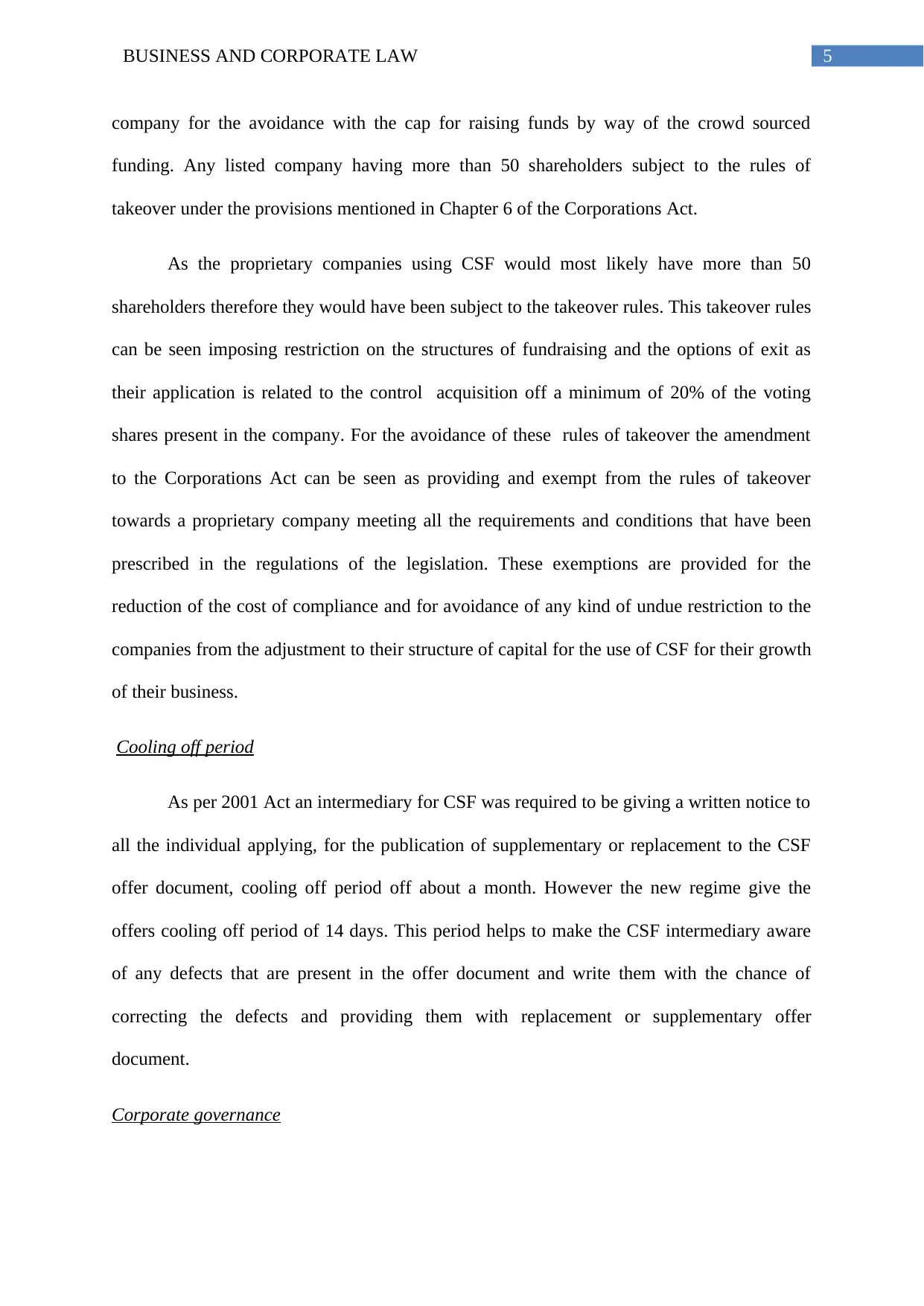
5BUSINESS AND CORPORATE LAW
company for the avoidance with the cap for raising funds by way of the crowd sourced
funding. Any listed company having more than 50 shareholders subject to the rules of
takeover under the provisions mentioned in Chapter 6 of the Corporations Act.
As the proprietary companies using CSF would most likely have more than 50
shareholders therefore they would have been subject to the takeover rules. This takeover rules
can be seen imposing restriction on the structures of fundraising and the options of exit as
their application is related to the control acquisition off a minimum of 20% of the voting
shares present in the company. For the avoidance of these rules of takeover the amendment
to the Corporations Act can be seen as providing and exempt from the rules of takeover
towards a proprietary company meeting all the requirements and conditions that have been
prescribed in the regulations of the legislation. These exemptions are provided for the
reduction of the cost of compliance and for avoidance of any kind of undue restriction to the
companies from the adjustment to their structure of capital for the use of CSF for their growth
of their business.
Cooling off period
As per 2001 Act an intermediary for CSF was required to be giving a written notice to
all the individual applying, for the publication of supplementary or replacement to the CSF
offer document, cooling off period off about a month. However the new regime give the
offers cooling off period of 14 days. This period helps to make the CSF intermediary aware
of any defects that are present in the offer document and write them with the chance of
correcting the defects and providing them with replacement or supplementary offer
document.
Corporate governance
company for the avoidance with the cap for raising funds by way of the crowd sourced
funding. Any listed company having more than 50 shareholders subject to the rules of
takeover under the provisions mentioned in Chapter 6 of the Corporations Act.
As the proprietary companies using CSF would most likely have more than 50
shareholders therefore they would have been subject to the takeover rules. This takeover rules
can be seen imposing restriction on the structures of fundraising and the options of exit as
their application is related to the control acquisition off a minimum of 20% of the voting
shares present in the company. For the avoidance of these rules of takeover the amendment
to the Corporations Act can be seen as providing and exempt from the rules of takeover
towards a proprietary company meeting all the requirements and conditions that have been
prescribed in the regulations of the legislation. These exemptions are provided for the
reduction of the cost of compliance and for avoidance of any kind of undue restriction to the
companies from the adjustment to their structure of capital for the use of CSF for their growth
of their business.
Cooling off period
As per 2001 Act an intermediary for CSF was required to be giving a written notice to
all the individual applying, for the publication of supplementary or replacement to the CSF
offer document, cooling off period off about a month. However the new regime give the
offers cooling off period of 14 days. This period helps to make the CSF intermediary aware
of any defects that are present in the offer document and write them with the chance of
correcting the defects and providing them with replacement or supplementary offer
document.
Corporate governance
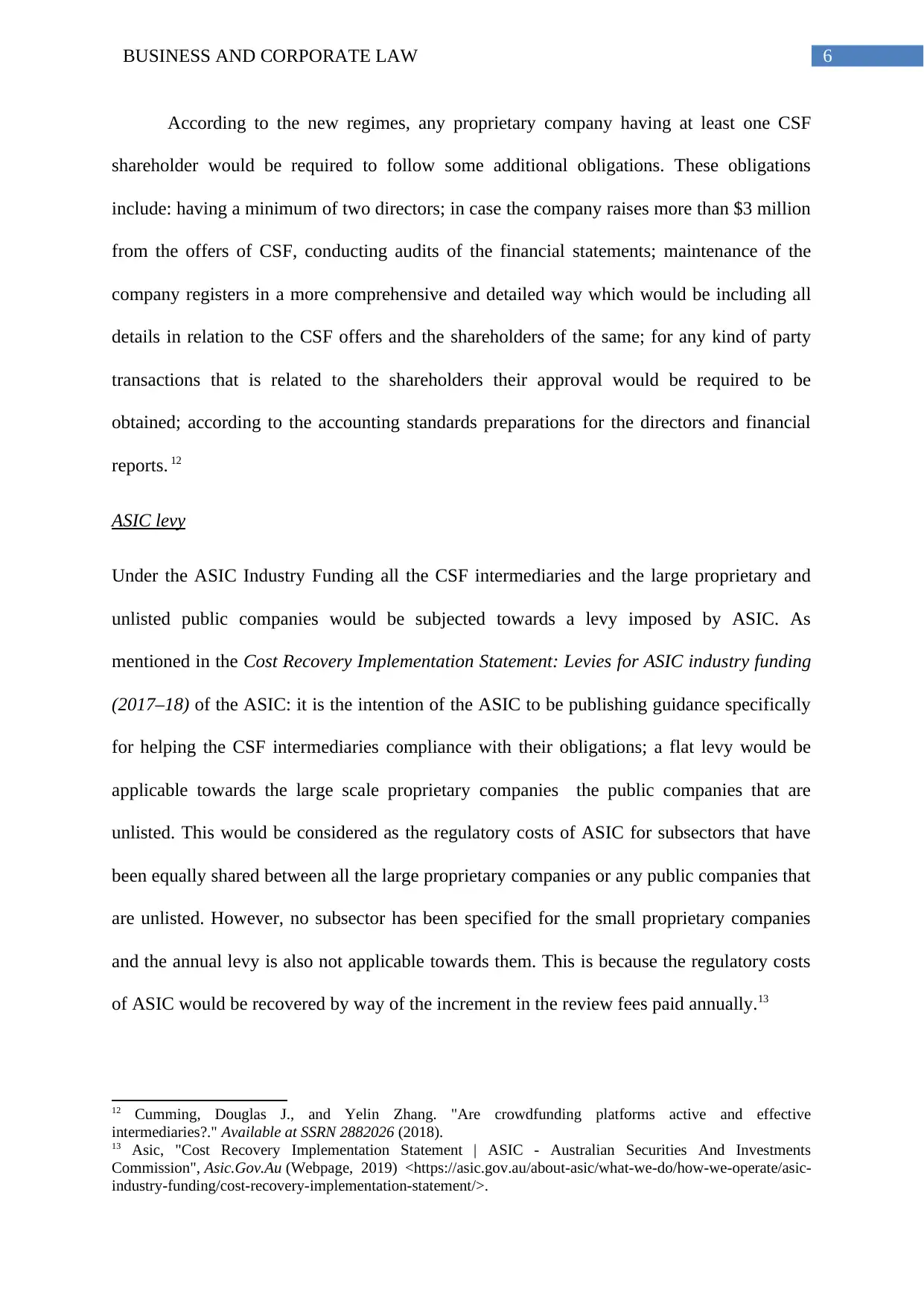
6BUSINESS AND CORPORATE LAW
According to the new regimes, any proprietary company having at least one CSF
shareholder would be required to follow some additional obligations. These obligations
include: having a minimum of two directors; in case the company raises more than $3 million
from the offers of CSF, conducting audits of the financial statements; maintenance of the
company registers in a more comprehensive and detailed way which would be including all
details in relation to the CSF offers and the shareholders of the same; for any kind of party
transactions that is related to the shareholders their approval would be required to be
obtained; according to the accounting standards preparations for the directors and financial
reports. 12
ASIC levy
Under the ASIC Industry Funding all the CSF intermediaries and the large proprietary and
unlisted public companies would be subjected towards a levy imposed by ASIC. As
mentioned in the Cost Recovery Implementation Statement: Levies for ASIC industry funding
(2017–18) of the ASIC: it is the intention of the ASIC to be publishing guidance specifically
for helping the CSF intermediaries compliance with their obligations; a flat levy would be
applicable towards the large scale proprietary companies the public companies that are
unlisted. This would be considered as the regulatory costs of ASIC for subsectors that have
been equally shared between all the large proprietary companies or any public companies that
are unlisted. However, no subsector has been specified for the small proprietary companies
and the annual levy is also not applicable towards them. This is because the regulatory costs
of ASIC would be recovered by way of the increment in the review fees paid annually.13
12 Cumming, Douglas J., and Yelin Zhang. "Are crowdfunding platforms active and effective
intermediaries?." Available at SSRN 2882026 (2018).
13 Asic, "Cost Recovery Implementation Statement | ASIC - Australian Securities And Investments
Commission", Asic.Gov.Au (Webpage, 2019) <https://asic.gov.au/about-asic/what-we-do/how-we-operate/asic-
industry-funding/cost-recovery-implementation-statement/>.
According to the new regimes, any proprietary company having at least one CSF
shareholder would be required to follow some additional obligations. These obligations
include: having a minimum of two directors; in case the company raises more than $3 million
from the offers of CSF, conducting audits of the financial statements; maintenance of the
company registers in a more comprehensive and detailed way which would be including all
details in relation to the CSF offers and the shareholders of the same; for any kind of party
transactions that is related to the shareholders their approval would be required to be
obtained; according to the accounting standards preparations for the directors and financial
reports. 12
ASIC levy
Under the ASIC Industry Funding all the CSF intermediaries and the large proprietary and
unlisted public companies would be subjected towards a levy imposed by ASIC. As
mentioned in the Cost Recovery Implementation Statement: Levies for ASIC industry funding
(2017–18) of the ASIC: it is the intention of the ASIC to be publishing guidance specifically
for helping the CSF intermediaries compliance with their obligations; a flat levy would be
applicable towards the large scale proprietary companies the public companies that are
unlisted. This would be considered as the regulatory costs of ASIC for subsectors that have
been equally shared between all the large proprietary companies or any public companies that
are unlisted. However, no subsector has been specified for the small proprietary companies
and the annual levy is also not applicable towards them. This is because the regulatory costs
of ASIC would be recovered by way of the increment in the review fees paid annually.13
12 Cumming, Douglas J., and Yelin Zhang. "Are crowdfunding platforms active and effective
intermediaries?." Available at SSRN 2882026 (2018).
13 Asic, "Cost Recovery Implementation Statement | ASIC - Australian Securities And Investments
Commission", Asic.Gov.Au (Webpage, 2019) <https://asic.gov.au/about-asic/what-we-do/how-we-operate/asic-
industry-funding/cost-recovery-implementation-statement/>.
Paraphrase This Document
Need a fresh take? Get an instant paraphrase of this document with our AI Paraphraser
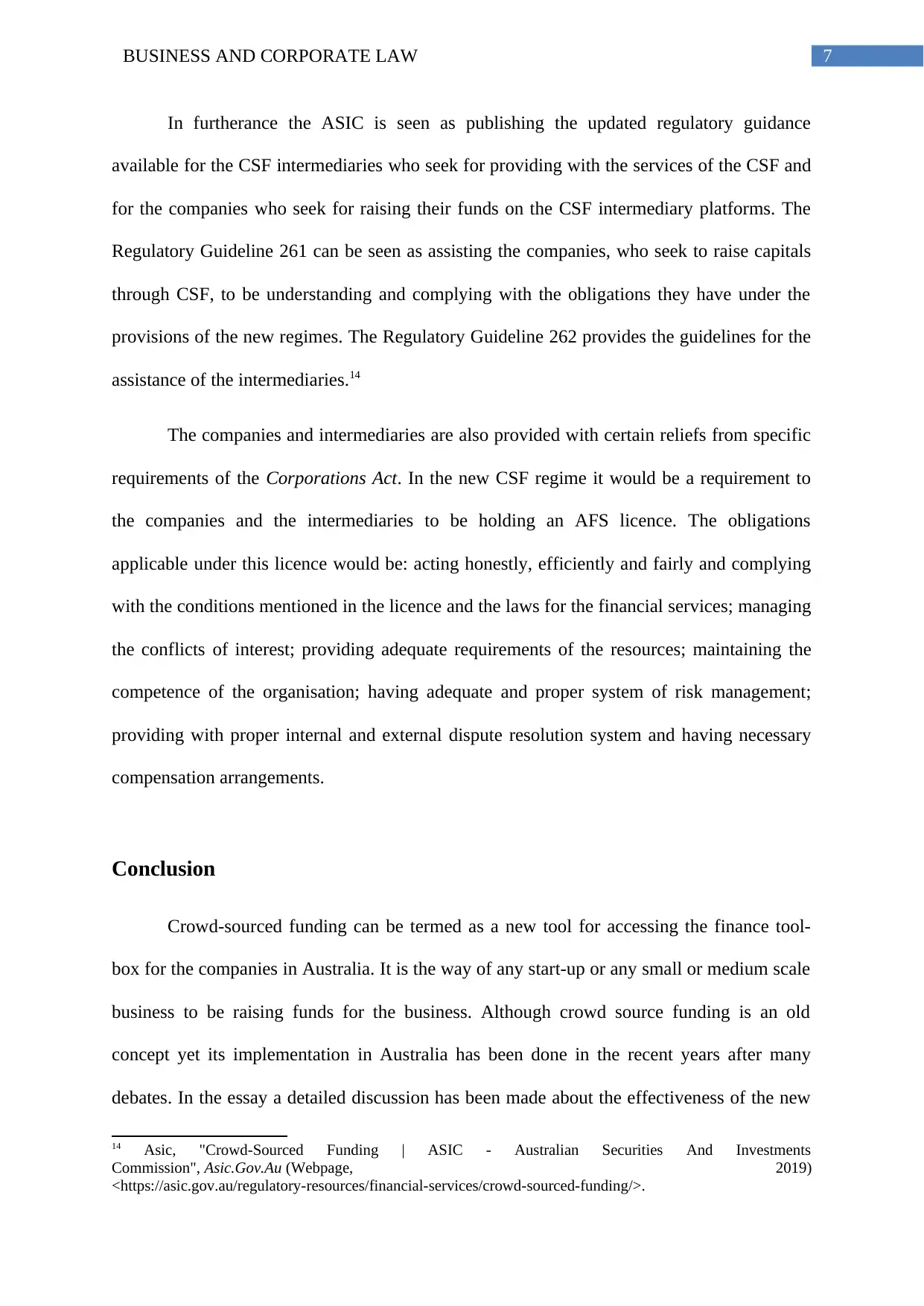
7BUSINESS AND CORPORATE LAW
In furtherance the ASIC is seen as publishing the updated regulatory guidance
available for the CSF intermediaries who seek for providing with the services of the CSF and
for the companies who seek for raising their funds on the CSF intermediary platforms. The
Regulatory Guideline 261 can be seen as assisting the companies, who seek to raise capitals
through CSF, to be understanding and complying with the obligations they have under the
provisions of the new regimes. The Regulatory Guideline 262 provides the guidelines for the
assistance of the intermediaries.14
The companies and intermediaries are also provided with certain reliefs from specific
requirements of the Corporations Act. In the new CSF regime it would be a requirement to
the companies and the intermediaries to be holding an AFS licence. The obligations
applicable under this licence would be: acting honestly, efficiently and fairly and complying
with the conditions mentioned in the licence and the laws for the financial services; managing
the conflicts of interest; providing adequate requirements of the resources; maintaining the
competence of the organisation; having adequate and proper system of risk management;
providing with proper internal and external dispute resolution system and having necessary
compensation arrangements.
Conclusion
Crowd-sourced funding can be termed as a new tool for accessing the finance tool-
box for the companies in Australia. It is the way of any start-up or any small or medium scale
business to be raising funds for the business. Although crowd source funding is an old
concept yet its implementation in Australia has been done in the recent years after many
debates. In the essay a detailed discussion has been made about the effectiveness of the new
14 Asic, "Crowd-Sourced Funding | ASIC - Australian Securities And Investments
Commission", Asic.Gov.Au (Webpage, 2019)
<https://asic.gov.au/regulatory-resources/financial-services/crowd-sourced-funding/>.
In furtherance the ASIC is seen as publishing the updated regulatory guidance
available for the CSF intermediaries who seek for providing with the services of the CSF and
for the companies who seek for raising their funds on the CSF intermediary platforms. The
Regulatory Guideline 261 can be seen as assisting the companies, who seek to raise capitals
through CSF, to be understanding and complying with the obligations they have under the
provisions of the new regimes. The Regulatory Guideline 262 provides the guidelines for the
assistance of the intermediaries.14
The companies and intermediaries are also provided with certain reliefs from specific
requirements of the Corporations Act. In the new CSF regime it would be a requirement to
the companies and the intermediaries to be holding an AFS licence. The obligations
applicable under this licence would be: acting honestly, efficiently and fairly and complying
with the conditions mentioned in the licence and the laws for the financial services; managing
the conflicts of interest; providing adequate requirements of the resources; maintaining the
competence of the organisation; having adequate and proper system of risk management;
providing with proper internal and external dispute resolution system and having necessary
compensation arrangements.
Conclusion
Crowd-sourced funding can be termed as a new tool for accessing the finance tool-
box for the companies in Australia. It is the way of any start-up or any small or medium scale
business to be raising funds for the business. Although crowd source funding is an old
concept yet its implementation in Australia has been done in the recent years after many
debates. In the essay a detailed discussion has been made about the effectiveness of the new
14 Asic, "Crowd-Sourced Funding | ASIC - Australian Securities And Investments
Commission", Asic.Gov.Au (Webpage, 2019)
<https://asic.gov.au/regulatory-resources/financial-services/crowd-sourced-funding/>.

8BUSINESS AND CORPORATE LAW
regimes for the crowd source funding and their applicability towards the companies and
intermediaries as well as the investors.
regimes for the crowd source funding and their applicability towards the companies and
intermediaries as well as the investors.
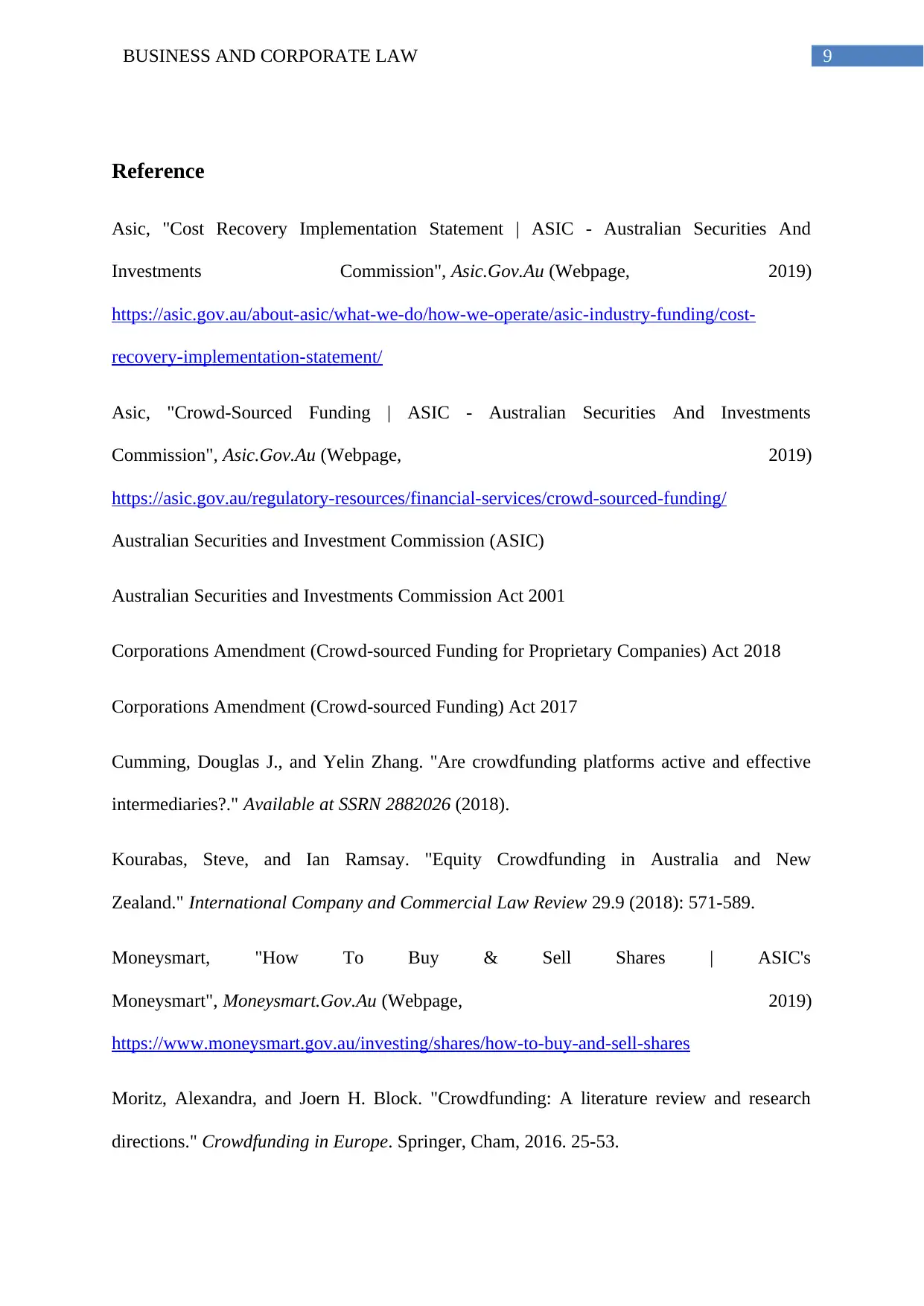
9BUSINESS AND CORPORATE LAW
Reference
Asic, "Cost Recovery Implementation Statement | ASIC - Australian Securities And
Investments Commission", Asic.Gov.Au (Webpage, 2019)
https://asic.gov.au/about-asic/what-we-do/how-we-operate/asic-industry-funding/cost-
recovery-implementation-statement/
Asic, "Crowd-Sourced Funding | ASIC - Australian Securities And Investments
Commission", Asic.Gov.Au (Webpage, 2019)
https://asic.gov.au/regulatory-resources/financial-services/crowd-sourced-funding/
Australian Securities and Investment Commission (ASIC)
Australian Securities and Investments Commission Act 2001
Corporations Amendment (Crowd-sourced Funding for Proprietary Companies) Act 2018
Corporations Amendment (Crowd-sourced Funding) Act 2017
Cumming, Douglas J., and Yelin Zhang. "Are crowdfunding platforms active and effective
intermediaries?." Available at SSRN 2882026 (2018).
Kourabas, Steve, and Ian Ramsay. "Equity Crowdfunding in Australia and New
Zealand." International Company and Commercial Law Review 29.9 (2018): 571-589.
Moneysmart, "How To Buy & Sell Shares | ASIC's
Moneysmart", Moneysmart.Gov.Au (Webpage, 2019)
https://www.moneysmart.gov.au/investing/shares/how-to-buy-and-sell-shares
Moritz, Alexandra, and Joern H. Block. "Crowdfunding: A literature review and research
directions." Crowdfunding in Europe. Springer, Cham, 2016. 25-53.
Reference
Asic, "Cost Recovery Implementation Statement | ASIC - Australian Securities And
Investments Commission", Asic.Gov.Au (Webpage, 2019)
https://asic.gov.au/about-asic/what-we-do/how-we-operate/asic-industry-funding/cost-
recovery-implementation-statement/
Asic, "Crowd-Sourced Funding | ASIC - Australian Securities And Investments
Commission", Asic.Gov.Au (Webpage, 2019)
https://asic.gov.au/regulatory-resources/financial-services/crowd-sourced-funding/
Australian Securities and Investment Commission (ASIC)
Australian Securities and Investments Commission Act 2001
Corporations Amendment (Crowd-sourced Funding for Proprietary Companies) Act 2018
Corporations Amendment (Crowd-sourced Funding) Act 2017
Cumming, Douglas J., and Yelin Zhang. "Are crowdfunding platforms active and effective
intermediaries?." Available at SSRN 2882026 (2018).
Kourabas, Steve, and Ian Ramsay. "Equity Crowdfunding in Australia and New
Zealand." International Company and Commercial Law Review 29.9 (2018): 571-589.
Moneysmart, "How To Buy & Sell Shares | ASIC's
Moneysmart", Moneysmart.Gov.Au (Webpage, 2019)
https://www.moneysmart.gov.au/investing/shares/how-to-buy-and-sell-shares
Moritz, Alexandra, and Joern H. Block. "Crowdfunding: A literature review and research
directions." Crowdfunding in Europe. Springer, Cham, 2016. 25-53.
Secure Best Marks with AI Grader
Need help grading? Try our AI Grader for instant feedback on your assignments.

10BUSINESS AND CORPORATE LAW
Storey, Jill. "Crowdfunding assists Agtech with crucial challenge." Australasian
Biotechnology 28.2 (2018): 36.
Storey, Jill. "Crowdfunding assists Agtech with crucial challenge." Australasian
Biotechnology 28.2 (2018): 36.
1 out of 11
Related Documents
Your All-in-One AI-Powered Toolkit for Academic Success.
+13062052269
info@desklib.com
Available 24*7 on WhatsApp / Email
![[object Object]](/_next/static/media/star-bottom.7253800d.svg)
Unlock your academic potential
© 2024 | Zucol Services PVT LTD | All rights reserved.





